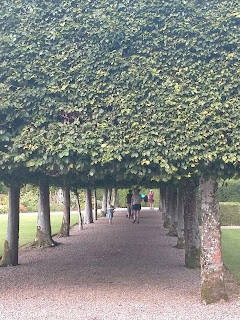19th Century "Influencers"
Social media has given everyone the opportunity to become an
“Influencer” – people whose authority, knowledge or positions with their
audience have the power to affect our decisions.
There were influencers in the 19th Century. No more so than in the world of horticulture. Some of whom continue to influence our garden designs today. My own garden was greatly inspired by the writings of significant 19th Century horticulturists.
Gertrude Jekyll (1843-1932) - an artist and embroiderer, took up gardening at the age of 50 when her sight began to fail. She met Edwin Lutyens (1869-1944) at the beginning of his architectural career and formed a professional partnership. He designed the houses and their gardens along formal lines and she clothed them with plants. Gertrude Jekyll aimed for cottage garden informality and used winding paths and wildernesses. She was chiefly remembered for her herbaceous borders. The partnership with Edwin Lutyens, who became Sir Edwin in the course of a long and distinguished career as a leading architect, lasted thirty years and during that time they designed 300 gardens.
William Robinson (1838-1935) – at the end of the 19th century fashion swung from Formal Gardens with topiary in the classical, Italianate style and ceremonial municipal parks to a more naturalistic style. In the larger grounds the Wild Garden became a feature, encouraged by William Robinson, who although not a practical gardener was editor of the magazine “Gardening”.
John Ruskin (1819-1900) - the Arts and Crafts Movement was inspired by polymath John Ruskin and garden designers such as Gertrude Jekyll. People turned away from the baroque garden and back towards the relative simplicity and naturalness of the English Cottage Garden. The trend, initially started by the aristocracy, gradually filtered down to ordinary people. Until Queen Victoria’s succession to the thrown in 1837 gardens were largely used to grow plants that were useful. Gradually flowers crept into gardens simply on the grounds that they were beautiful.
Thomas Mawson (1861-1933) - a gentle man, a devout Christian all his life was a prolific and influential designer who, in his writings, stressed the importance of gardens to the enrichment of the lives of all mankind.
Reginald Farrer (1880-1920) - rock gardens and the growing of Alpine plants also became fashionable due to the plant hunting expeditions of Reginald Farrer and his book “The English Rock Garden”.
G. F. Wilson (1822-1902) - an industrial chemist who started the Royal Horticultural Society Gardens at Wisley, Surrey, in 1878 as a woodland garden. Sir Thomas Hanbury (1832-1907) purchased a 6 acre site and presented it to the RHS in 1903 – today RHS Wisley Gardens extend to over 200 acres.
Lawrence Johnson (1871-1958) - a citizen of the United States of America, who started his garden at Hidcote Manor, Gloucestershire, as a series of enclosed garden rooms with tapestry hedges combining Yew, Hornbeam, Holly, Box and Beech.
Arthur Soames (1886-1962) - the 3rd Earl of Sheffield (1876-1909) created Sheffield Park in East Sussex. Arboretums (tree gardens) were fashionable. Sheffield Park is a fine example started in 1909 in 140 acres planted for effect of form and colour. Azaleas, Magnolias, Camellias and other rare exotic flora were planted throughout Britain. The North West of England and Scotland, because of the warming influence of the North Atlantic Drift (the Gulf Stream, have many examples of rare exotic trees.
Specialist societies began such as the Working Mans’ Florist Clubs that held flower shows and propagated new varieties but by the end of the century they had been replaced by horticultural societies that specialised in growing the largest fruits and vegetables.
Allotments - started in Germany at the end of the 19th Century, as a use of wasteland fringing towns and cities, spread throughout Britain and the continent. The provision of Allotments was included in an Act of Parliament in Great Britain in 1887 when local governments had to provide allotments if there was a demand. The resistance of local authorities the Act of Smallholding and Allotment became law in 1907. This law created a renewed interest in producing safer food and allotments and organic gardening increased in popularity.
Garden design continues to be swayed by the influence of knowledgeable people and visiting gardens, whether in person or by viewing social media, has a strong affect on the shape of our gardens today







Comments
Post a Comment